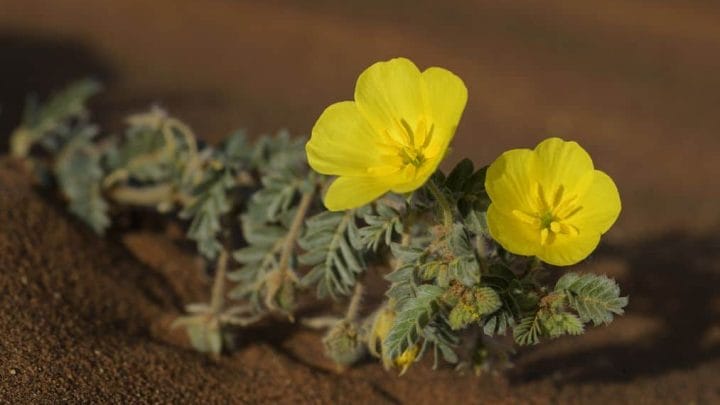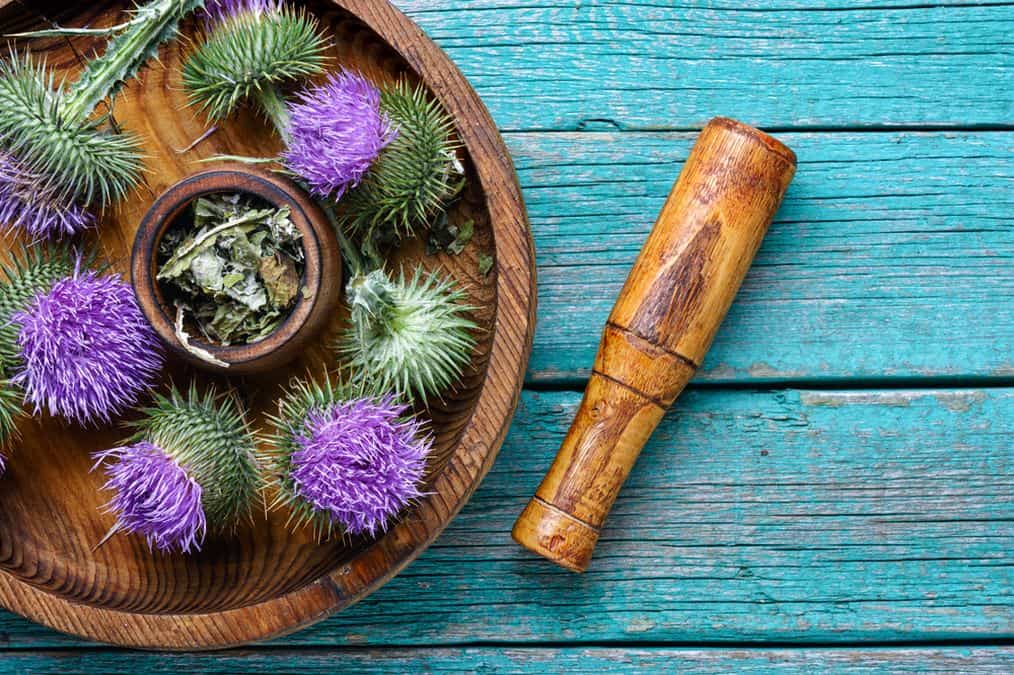
Thistle – properties and effects. Does thistle help to lose weight?
The liver is one of the most important and largest organs in the human body, without which we would not be able to function normally. Among other things, it helps cleanse the body of toxins, so we should take care of it throughout our lives. Any disorders immediately reflect negatively on the whole state of health, and more serious diseases of this organ can even be life-threatening. There are many methods to prevent this, and one of them is the use of plants with medicinal properties. The best in this role is thistle, the most effective in protecting the liver from possible infections and diseases.
Contents
Liver structure
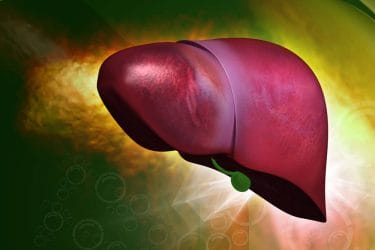
Before describing the composition and medicinal properties of milk thistle, we should learn what the liver actually is and how it is built. It is located on the right side of the human body, just below the diaphragm, with which it is partially fused, and its weight is 1500-1700 g in men and 1300-1500 g in women. It is composed of liver cells, called hepatocytes, which constitute as much as 80 to 95 per cent of its mass, and the liver consists of four partially interconnected lobes
- left;
- the right lobe, which is the largest
- quadrilateral;
- caudal.
The liver has a very strong blood supply, the blood is supplied by the hepatic artery, as much as 25 percent of the incoming blood, and another 75 percent is supplied by the portal vein, except that this is blood enriched with nutrients essential for health.
Liver – functions
In the words that it is one of the most important organs, there is really no exaggeration. Therefore, it is necessary to ensure that it can work without interference throughout life, which is exactly what thistle will help. The liver can safely be compared to a chemical factory, as it is responsible for numerous processes in the body, primarily for
- metabolic processes of substances subsequently absorbed in the digestive system;
- glycogen storage;
- production of compounds necessary for blood clotting, plasma proteins, albumin, prothrombin, fibrinogen;
- removing toxins and other, equally harmful substances, which we sometimes provide it with by drinking alcohol or eating improperly;
- production of cholesterol, which in turn is necessary for the production of bile acids;
- supporting the body’s immune system as it contains cells necessary for the proper functioning of the immune system.
Thistle – the origin of the plant
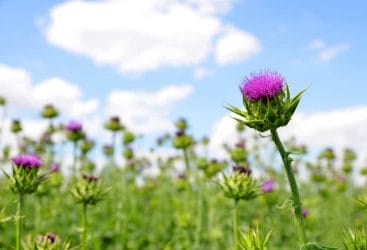
As a medicinal plant, thistle, Silybum marianum (L.), has been known and used for almost 2,000 years, initially only in the Mediterranean region. Over the centuries it has spread to other parts of the world, not only to our continent, but also to the Americas, North and South, Africa, and even distant Australia. It is cultivated in Poland, mainly in the Lublin, Kuyavia and Pomerania regions, and on an increasing scale.
Thistle is an annual plant belonging to the Asteraceae family, with an erect stem over a meter long and branched at the top. The leaves are spiny at the edges, green and covered with irregular white spots. The flowers of milk thistle are purple, gathered in trusses and bloom from late June to mid-August. After flowering, a dark fruit filled with seeds with flight down is formed, which is carried by the wind.
Thistle – active ingredients
The health-promoting properties of thistle fruits, as they are used in natural medicine, result from their composition, the content of valuable nutrients, and the most important is silymarin. It is obtained from the seeds of thistle and is a complex of several compounds, flavonoligans: silibin, silicristin, silydianin and isosylibin. It is thanks to them that silymarin proves effective in protecting liver cells from damage and accelerates their regeneration. Apart from it, thistle contains other active ingredients, such as:
Flavonoids
Bioactive compounds, including quercetin, which have a multifaceted health-promoting effect with extremely broad properties:
- antioxidant, as antioxidants they help rid the body of free radicals, reactive oxygen species that can lead to cell damage or destruction;
- anti-inflammatory, protecting against the development of dangerous inflammatory conditions;
- preventing aggregation, i.e. the sticking together of blood platelets, which poses a risk of venous thrombosis;
- lowering too high blood pressure;
- diuretics, helping to cleanse the body of toxins;
- antibacterial, antiviral and anti-allergic.
Phytosterols
Phytosterols are also known as plant sterols. Their structure somewhat resembles cholesterol, although they allow to effectively reduce the amount of its “bad” fraction LDL, while increasing the “good” HDL, they also have properties:
- anticancer, inhibiting the multiplication of cancer cells and protecting against their metastasis;
- enhancing immunity, which is also necessary for an effective fight against cancer;
- supporting the treatment of prostate hypertrophy;
- relieving the symptoms of menopause;
- anti-allergic;
- accelerating tissue regeneration;
- supporting the synthesis of collagen and elastin.
Essential oils
Those which contain fruits of milk thistle are a mixture of at least several dozens of volatile compounds which have an impact, in this case a positive one, on our health, with action of:
- antiseptic;
- antifungal;
- antimicrobial;
- facilitating expectoration;
- restoring normal intestinal peristalsis;
- Stimulates secretion of gastric juices;
- diuretic.
Vitamin B2
Bearing the name of riboflavin, with a very broad action, having primarily importance for the work of the immune and nervous systems , and its other functions are:
- protecting the body against inflammation;
- potentiation of the positive effects of insulin;
- participation in the production of red blood cells;
- regulating the secretion of cortisol, known as the “stress hormone”, which has anti-inflammatory properties;
- protection of the eyes against cataracts;
- protecting the mucous membranes of the gastrointestinal tract from disease and damage;
- guaranteeing the child’s normal growth;
- regulation of blood pressure and heart rhythm;
- counteracting the negative effects of oxidative stress.
Vitamin C
Since thistle is a medicinal plant, it must also contain vitamin C, i.e. ascorbic acid, without which we are not able to function normally, because it is responsible for:
- increasing the absorption of iron;
- the formation of red blood cells
- production of collagen, the building material of numerous tissues;
- synthesis of neurotransmitters, therefore it has an influence on correct functioning of the brain;
- strengthening of the body’s immune system;
- protection against free radicals, it is another powerful antioxidant;
- prevention of bone calcification;
- sealing weakened walls of blood vessels;
- reducing “bad” cholesterol levels and lowering blood pressure that is too high.
Vitamin E
Milk thistle also contains large amounts of vitamin E, commonly known as the “vitamin of youth”whose main function is:
- Preventing the already mentioned platelet aggregation, which is an important part of the protection against blood clots;
- preventing the formation of atherosclerotic plaques;
- Minimizing the risk of cancer;
- delaying natural skin aging processes;
- regulating blood sugar levels;
- Preventing fetal malformations with simultaneous folic acid supplementation;
- relieve symptoms of premenstrual syndrome.
Minerals
Minerals are considered by many specialists to be equally essential, and in many cases even more important, than vitamins, just as they take an active part in many processes occurring in the body. They are the building material of tissues, including bone tissue, regulate metabolic processes and the secretion of enzymes responsible for the proper functioning of internal organs. The therapeutic effect of thistle fruits is ensured mainly by three elements:
- zinc, present in many enzymes, it is estimated that in more than 80, regulating the functioning of the pancreas, anti-inflammatory, strengthening immunity, increasing fertility, supporting the treatment of many diseases, such as acne, hemorrhoids and diabetes, preventing dementia;
- selenium, with antioxidant properties. Minimizes the risk of heart disease, cardiovascular disease and cancer, improves blood flow, supports thyroid function, increases fertility by improving semen quality, ensures good memory and proper fetal development, supports the immune system;
- copper, counteracting diseases of the circulatory system and heart, acting antibacterially, participating in transportation of oxygen to cells and production of melanin, a pigment of the skin and hair. It is responsible for the increase of mental abilities, better memory, concentration and memorizing ability, it protects cell membranes against damage and ensures proper blood clotting level.
Thistle – a positive influence on health
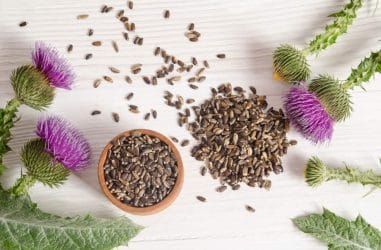
As you can see, the composition of thistle is so rich that it translates into its action to support weakened health in a wide range. This is made possible not only by silymarin, but also by other nutrients, the action of which I have presented in more detail in their descriptions. However, it is worth summarizing the medicinal properties of thistle, and its supplementation carries the following benefits:
Support for a weakened liver
The already presented and most important use by which milk thistle is gaining ever-increasing popularity. It is considered extremely effective for all ailments of this organ, especially those caused by toxins and other harmful substances. It facilitates the regeneration of liver cells, protects them from the accumulation of too much collagen, seals the cell membranes of hepatocytes.
It is thanks to the components of this plant that the liver is protected against the negative effects of alcohol, improperly selected diet or the effects of taking strong medicines, e.g. antibiotics. Thistle prevents cirrhosis, fatty liver, hepatitis C, and inflammation of the gall bladder and bile ducts, so it is used in the prevention of cholelithiasis. The liver parenchyma is also protected, especially from the effects of the toxins mentioned above.
More efficient digestion and aid in weight loss
Also due to the properties of silymarin stimulating the digestive system to work more efficiently. Better digestion results directly from regulation of liver function, it also speeds up metabolism allowing for faster burning of excess calories and fat tissue, while its diuretic properties allow for removal of excess water from the body.
Other components of thistle described above are also an effective support in the fight against overweight and obesity, and in the treatment consisting in a healthy diet and physical activity. They suppress the appetite, give energy to exercise, alleviate such ailments of the digestive system as flatulence, diarrhea and indigestion, and regulate blood glucose levels.
SLIMMING PILLS – RANKING 2021
Milk thistle – other properties and uses
Thistle is appreciated by patients and specialists also for other healing properties, among which it is worth emphasizing:
- strengthening the capillaries protecting them from breaking and the skin from the formation of spider veins and varicose veins;
- taking care of the skin’s appearance, especially its proper hydration, which allows to maintain its firmness and avoid premature wrinkles; thistle also soothes irritations and acne changes
- relieving the symptoms of varicose veins of the anus, i.e. hemorrhoids;
- preventing nose and intestinal bleeding;
- regulating the secretion of gastric juices;
- alleviating severe migraine headaches;
- support of osteoporosis treatment.
In various treatments supporting the health of our body, ground thistle is the best choice, as an addition to meals, drinks, green tea or yogurt. It can also be found in dietary supplements, such as weight loss pills, and even in oil. The recommended daily dose is a maximum of 15 g per day, which is about 400 mg of pure silymarin. It should not be exceeded, as unpleasant gastrointestinal problems, diarrhea or vomiting may occur.
Thistle – possible side effects and contraindications
Milk thistle usually does not have any side effects, except if someone is just allergic to any of the plants belonging to the Asteraceae family, then they may experience shortness of breath and skin irritation. It should also not be used by pregnant and lactating women, children under the age of 12 and people with diabetes, as it significantly lowers blood glucose levels.
Sources:
- https://www.healthline.com/nutrition/milk-thistle-benefits
- https://www.medicalnewstoday.com/articles/320362


